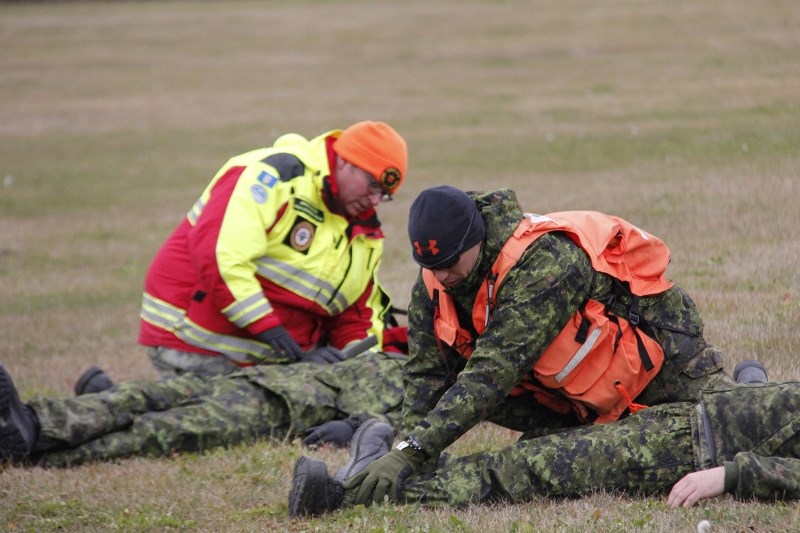It was the first time 4 Wing Ground Search and Rescue (GSR) and 417 Combat Support Squadron trained alongside each other in preparation for a casualty situation.
On Thursday, Oct. 6, members braved the cold as they participated in a training scenario involving several wounded, and three casualties at 4 Wing Cold Lake.
Those involved in the accident were injured, each suffering a different type of injury, including protruding eyes, pain in their chest, broken bones, and even death. With the assistance of 417 Combat Support Squadron, an airborne search and rescue unit, GSR helped in aiding those wounded, and carried them to the helicopter to be transported to a nearby hospital.
Dylan Grimm, officer in command for the GSR team, said this is the first time the two teams have trained together, even though they often rely on each other in these situations.
“In real life we are going to be responding together, and whether we like it or not, both teams are going to be mobilized at the same time. The more we practice working together in a training environment, the easier it will make it for when it happens in real life.”
Throughout the week, GSR was qualifying new members in the basic search and rescue course, which is considered the baseline form of skills necessary to perform search and rescue missions. This was just one of their training exercises.
Deputy Search and Rescue Technician for 417 Combat Support Squadron Master Cpl. Geoff Rowan, said the two teams may share a common goal, but they operate very differently in terms of execution.
“We are helicopter based, we are working in the air and we have a lot of resources that we can call upon, whereas (GSR) are more self-sustained, and function on the ground capacity to get where they are going.”
Rowan has been involved with search and rescue for nine years through the Royal Canadian Armed Forces, and said the training provided an opportunity for both teams to work together and see each other's roles in a casualty situation.
“Them having an understanding of our capabilities, how to operate the chopper, and what we can do for them and what they can do for us, makes things run a lot smoother.”
Both teams rely on each other to aid in rescuing those involved in remote incidences, where services such as EMS, the fire department, and local police are unavailable or can't gain access.
While 417 responds and begins searching in the air, GSR units will be searching on foot.
Rowan said, “They may come across it (the scene) first, and if they do, they are going to be alone in the situation until we arrive, and then we can start working together to work just like we are here.”
Prior to Thursday's training, both teams would train separately. They decided to combine their training into one, as a way of improving their skills as a team. The training involved step by step guidance by SAR technicians such as Rowan.
SAR technicians are required to be trained in scuba diving, mountain climbing, skydiving, paramedicine and survival, and are often away on training. With only three SAR technicians on the base, the two teams have not had the opportunity to train together until this point.
“Really it's just lack of resources and man power,” explained Rowan.
“We are both really doing the same function in terms of search and rescue, so in a real life scenario there might be an instance where they might not be able to respond fully, or we might not be able to respond fully. By having the two teams working together it just better prepares us for this scenario in the future,” noted Grimm.
The scenario played out similar to a real-life situation, and acted as a lesson on how to work with minimal resources in a high stress environment.
Rowan concluded, “It's going to solidify the entire system, so when we do get called out, and these resources are deployed in full, than we can all come together, and it would happen efficiently with the best patient care and the most number of people being saved.”



